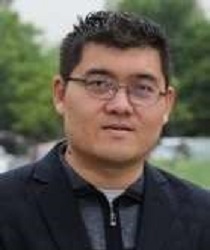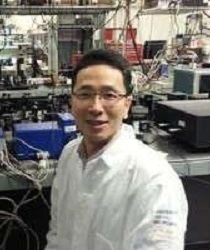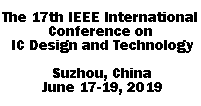Tutorial Program
The Monday afternoon, June 17th, 2019 is devoted to tutorials.
A certificate of attendance will be issued to all tutorial participants.
Participants requiring also the certification of academic credits for the tutorials have to go through an exam (questionnaire) at the end of the tutorial program.
The tutorial program is the following:
Topic: Artificial intelligence and emerging memories
13:00-14:20 Tutorial 1
Title: Resistive memories for neuromorphic hardware

Dr. Elisa Vianello, CEA-LETI
Abstract: Resistive random-access memory (RRAM) is a memory technology that promises high-capacity, non-volatile data storage, low voltages, fast programming and reading time, single bit alterability, and easiness of integration in the Back-End-Of-Line of advanced CMOS logic. This will revolutionize traditional memory hierarchy and facilitate the implementation of in-memory computing architectures and Deep Learning accelerators. RRAM devices also represent one possible path for design non-von Neumann systems where logic and memory are entirely merged. Two different flavors of non-von Neumann systems will be presented: artificial neural networks (ANNs), and spiking neural networks (SNNs). ANNs includes convolutional neural networks, multilayer perceptrons and binarized neural networks and, are trained using supervised learning and error Backpropagation. Arrays of analog resistive memory elements represent matrices of synaptic weights. They are ideally suited for the multiply-accumulate operations at the heart of forward-inference and training. SNNs (also called 3rd generation of neural networks) are more biologically-inspired. SNNs incorporate the concept of time into their operating model. They operate using spikes, which are discrete events that take place at points in time, rather than continuous values. Resistive memories can be incorporated into neuron and synapse circuits allowing memory to be truly co-localised with the computational units and facilitating the realisation of massively parallel local plasticity mechanisms such as spike-timing-dependent-plasticity that is believed to be a foundation of learning in the brain. Second, RRAMs can play a role in the design of asynchronous routing. RRAM-based ternary-content addressable memory (TCAM) are a compact solution for implementing reconfigurable multi-core neuromorphic architectures.
Bio: Dr. Elisa Vianello is from CEA-LETI (Laboratory of Electronics, Technology and Instrumentation of CEA, Grenoble). She received her Ph.D. Electrical Engineering in 2001 from Università degli Studi di Udine (Italy) and the Grenoble Institute of Technology (France). She joined CEA Leti in 2011 after spending one year as research staff at Fondazione Bruno Kessler, Italy working on the development of advanced Silicon Radiation Detectors for the upgrade of the Large Hadron Collider at the CERN (Genève). Since 2018, she is LETI senior expert on non-volatile memories and neuromorphic computing hardware. Her current research interests concern the development of new technologies for bio-inspired neuromorphic computing, with special focus on new resistive memory devices. She is author or co-author of more than 100 technical papers (conferences and journals) and 4 book chapters. She is a reviewer of several international journals (Nature Communication, Nature Electronics, Scientific Reports, IEEE Elec. Dev. Let., IEEE Trans. on Electr. Dev., Neural Networks). She was in the technical committee of the IRPS Symposium (2013-2014) and in the TCP of the IEDM (2016-2017). She is in the TPC of the ESSDERC Conference and she is in the Cass Nano-Giga TC.
14:20-14:30 Break
14:30-15:50 Tutorial 2
Title: Theory and Application of Visual Structure Learning

Prof. Xi Li, Zhejiang University
Abstract: In the era of Internet, huge amounts of video data have emerged. It is urgent to extract knowledge from these massive video data by various artificial intelligence technologies. Therefore, how to carry out artificial intelligence-driven visual computing has become the core technical problem. This report mainly focuses on data-driven artificial intelligence learning methods, and carries out large-scale image/video data visual structure learning. It deeply analyses the visual perception characteristics, visual feature expression, depth learner construction mechanism, high-level semantic understanding and other multi-dimensional perspectives, and introduces the main research issues and technical methods involved in large-scale visual structure learning. Then systematically reviews the different stages of development in the field of visual structure expression and learning, and introduces a series of representative research work and its practical application in visual semantic analysis and understanding by using visual structure learning in recent years.
Bio: Prof. Xi Li was selected into a national “Thousand Youth Talents Program”, winner of Zhejiang Provincial Science Foundation for Outstanding Young Scholars, and was appointed as a distinguished expert of the Zhejiang Province government. Also, he served as a council member of the China Image and Graphics Society. Meanwhile, he had a wealth of academic experience in serving as program committee members of top conferences (e.g., NIPS, ICML, CVPR, ICCV) or reviewers of premier journals (e.g., IEEE TPAMI, IJCV, IEEE TIP). Besides, he was invited as conference speakers of many well-known conferences at home and abroad (i.e., RACV 2016, ICSW 2017, ICDS 2017, IEEE FMT 2018). His research interests mainly focus on the fields of computer vision and machine learning, and has published approximately 130 top conferences and leading journal papers with about 3100 Google Scholar citations. He devoted his efforts to enabling many academic roles in conference organization (e.g., ICPR 2018 AC and ICCV 2019 AC) and journal editorial management (e.g., AEs of Neurocomputing and Neural Processing Letters). He won two Best International Conference Paper Awards (including ACCV 2010 and DICTA 2012), an ICIP 2015 Top 10% Conference Paper Award, and an ACML 2017 Best Student Paper Award. In addition, they won two China Natural Science and Technology Awards (including first-class and second-class prizes) and a Chinese Patent Excellence Award.
15:50-16:00 Break
16:00-17:20 Tutorial 3
Title: Spin-Torque Technologies: From Data Storage to Artificial Intelligence

Prof. Jeongmin Hong, Huazhong University of Science and Technology
Abstract: Addition of another dimension in information technology offers many exciting opportunities such as data storage, memory, memristor, security, neuromorphic computing. Spin transfer torque and spin orbit torque are two of main streams in spintronics research for the past decades. Most of them focus on memory applications. Dimensional expansion would increase many functionalities for future generation electronics. This talk will cover the current status of technical development in 3D spintronics using state-of-the-art spin torque devices.1–6
[1] Hong et al., “3D multilevel spin transfer torque devices,” Appl. Phys. Lett., 112, 112402 (2018).
[2] Amos et al., “Multilevel-3D Bit Patterned Magnetic Media with 8 Signal Levels Per Nanocolumn,” PLoS ONE, 7, e40134 (2012).
[3] Hong et al., “Dual Magnetic Tunnel Junction based Synaptic Neuron Devices,” Nat Commup, Under Review.
[4] Luo et al., “Voltage-Controlled Skyrmion Memristor for Energy-Efficient Synapse Applications,” IEEE Electron. Dev. Lett., 181, 31 (2019).
[5] Zhang et al., “Memristors: A Spin-Orbit Torque Memristive Device,” Adv. Electron. Mater., 5, 1970022 (2019).
[6] Chen et al., “Highly Secure Physically Unclonable Cryptographic Primitives based on Interfacial Magnetic Anisotropy,” Nano Lett. 18, 7211 (2018).
Bio: Jeongmin Hong obtained his master’s degree from Rensselaer Polytechnic Institute, Troy NY and PhD from the University of California-Riverside, Riverside CA followed by his bachelor’s degree from Pukyong National University, Busan Korea. During the study, he received Korean government fellowship to study abroad and Dean’s Distinguished Fellowship which is one of the highest level of fellowship offered by the University of California. He worked at Korea Institute of S&T Evaluation and Planning (KISTEP), Seoul; Pixel Optics, Fremont, CA; and JS Nanotech, San Jose, CA, USA. From 2012 to 2016, he was at UC Berkeley and Lawrence Berkeley National Lab, Berkeley CA and a research professor at Florida International University from 2016 to 2017. He is currently a full professor in the School of Optical and Electronic Information, Huazhong University of Science and Technology, Wuhan CN. His research includes various magnetic materials and devices for spintronics applications. He has authored more than 40 journal articles, given 20 invited presentations, and holds 2 patents.

